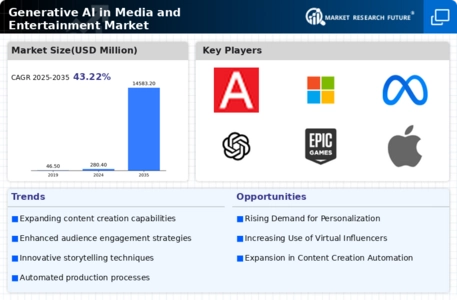Top Industry Leaders in the Generative AI in Media and Entertainment Market
The Competitive Landscape of Generative AI in Media and Entertainment
The media and entertainment (M&E) industry is witnessing a transformative phase, empowered by the burgeoning potential of generative AI. This technology is no longer relegated to science fiction; it's rapidly reshaping content creation, audience engagement, and business models across the spectrum, from gaming to film, music to advertising. Understanding the competitive landscape in this burgeoning market is crucial for both established players and newcomers.
Key Players:
-
Open AI
-
NVIDIA Corporation
-
Epic Games, Inc.
-
Amazon
-
Apple Inc.
-
Microsoft
-
Adobe Inc.
-
Unity Technologies
-
Meta Platforms, Inc.
-
Hughes Hubbard & Reed
-
IBM Corporation
-
Cohere
-
Anthropic
-
Others.
Strategies Adopted:
Players in this competitive space are deploying various strategies to gain an edge:
- Specialization: Companies like Jukebox are focusing on specific niches like music, while others like RunwayML target visual content. This focused approach allows them to develop deeper expertise and attract a dedicated user base.
- Partnerships: Strategic collaborations are common, leveraging each partner's strengths. Startups often partner with established M&E companies for data access, market reach, and industry expertise. Tech giants, meanwhile, collaborate with universities and research institutions to advance the technological frontiers.
- Open-source initiatives: Some players, like OpenAI, share their technology through open-source platforms. This fosters innovation by democratizing access to powerful tools and encouraging community contributions.
- Building user-friendly interfaces: User experience is key, and companies are developing intuitive interfaces to make generative AI tools accessible to creators with varying technical backgrounds.
Factors for Market Share Analysis:
Analyzing market share in this nascent landscape requires a nuanced approach, considering factors beyond traditional metrics like revenue:
- Technological prowess: The depth and breadth of a company's AI capabilities, including the quality and diversity of its generative models, will be crucial.
- Data access and utilization: The ability to access and harness vast amounts of diverse data for training AI models is a key differentiator.
- User base and engagement: Platforms with a sizeable and engaged user community generate valuable feedback and data, driving further development.
- Ecosystem partnerships: Companies with strong partnerships across the M&E value chain gain wider distribution and market penetration.
- Ethical considerations: Responsible development and deployment of generative AI, with focus on mitigating potential biases and addressing ethical concerns, will be critical for long-term success.
New and Emerging Companies:
The generative AI landscape is constantly evolving, with new players emerging rapidly. Some promising newcomers include:
- Latent Space: Pioneering generative models for 3D content creation, enabling users to design realistic characters, objects, and environments.
- Merlyn.ai: Focusing on AI-powered storytelling, offering tools for automatic script generation and dynamic narrative branching.
- Amper Music: Creating personalized music experiences through AI-powered composition and adaptation, tailoring music to individual preferences and contexts.
Current Company Investment Trends:
Investment in generative AI for M&E is on the rise, with both venture capital firms and established corporations increasing their stakes. The focus is on:
- Developing next-generation generative models: Pushing the boundaries of AI capabilities with more sophisticated and versatile models.
- Building user-friendly platforms and tools: Streamlining access to generative AI for creators of all levels.
- Exploring new applications: Expanding the reach of generative AI beyond traditional M&E formats into e-commerce, education, and other industries.
Latest Industry News:
Jan 27, 2024: OpenAI and Lucasfilm announced a collaboration to explore the use of large language models for interactive storytelling experiences within the Star Wars universe. This partnership aims to develop narrative frameworks that adapt and respond to user choices, potentially shaping the future of interactive narratives.
Jan 20, 2024: AI music platform Jukebox unveiled "Composer.ai," a beta service that lets users generate custom soundtracks and musical pieces based on their preferences and emotional inputs. This marks a significant step towards personalized music creation powered by AI.
Jan 18, 2024: Disney Research showcased "Project Lumiere," a generative AI system that enables real-time lighting and rendering for animated scenes. This technology promises to dramatically reduce production time and costs for animated films and shows.
Jan 13, 2024: Netflix revealed its use of generative AI to create personalized thumbnails and trailers for users, tailored to their viewing history and preferences. This aims to improve user engagement and content discovery through more targeted visual content.
Jan 10, 2024: Meta AI released "MakeIt," a generative AI system that allows users to create 3D objects and scenes simply by describing them in text. This opens up new possibilities for rapid prototyping and design in various fields, including gaming and product development.
Jan 5, 2024: A deepfake video of Tom Cruise went viral, sparking renewed concerns about the potential for misuse of this technology. This highlights the need for robust ethical frameworks and regulations to ensure responsible development and deployment of generative AI across media and entertainment.
Dec 1, 2023: Virtual influencers created using generative AI are gaining popularity on social media platforms, attracting brand partnerships and engaging audiences with their synthetic personas. This trend challenges traditional influencer marketing and opens up new avenues for brand messaging.

